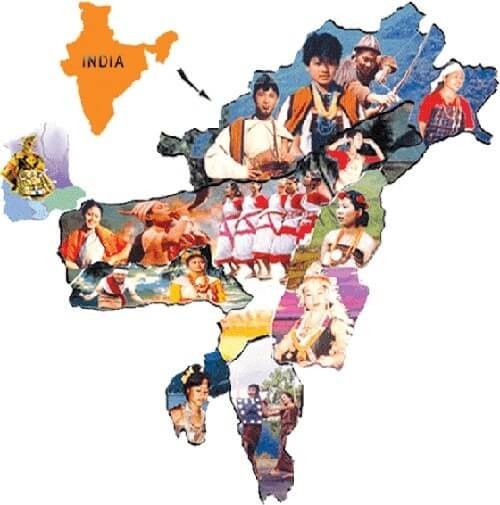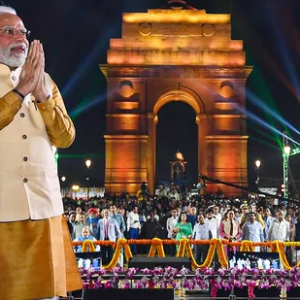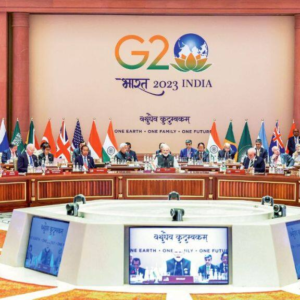Intricate inter-play of conflict dynamics, trans-border linkages, geo-political complications,
geographical incongruities, ethnic diversity and plethora of demands ranging from autonomy to self-determination to complete secession from India have always been the force multipliers for extremism in the North East. 5,300 km of highly volatile and extremely porous borders that the 2,63,000 sq km North East shares with four enigmatic, if not entirely inimical neighbours only add to the complexity of the situation.
Fertile ground for militancy
North East, which accounts for nearly 7.7 percent of India’s land mass and 3.1 percent of India’s population, was the first region where eruption took place against the Indian state soon after Independence and it is the longest lasting insurgency till date. Militancy in Kashmir and Left Wing Extremism (LWE) came much later. In North East, it began with Nagas in 1952 and the Mizos joined the militancy bandwagon in 1965. Manipur too, saw the sprouting of a plethora of extremist organizations – some espousing the Meitei or Kanglai cause, some pitting SanamahiDhama against Vaishnavism introduced from the land of Bengal, yet others pitting Meiteis against the Naga-Kuki-Chin tribal block. Then, the restive tribals of Tripura too took to arms with the likes of BinodJamatia and BijoyHrankhawl leading the insurgency.
Assam, the most populous of the seven sisters, too had its separatist tendencies long before India’s Independence. Foremost intellectual of the 1930s, Jnannath Bora, had questioned the inclusion of Assam in the British India. Before that Kamalakantha Bhattacharya, editor of AsomHitoishi, espoused the same cause.1 In fact, there has always been a strand of intellectual class that questioned the treaty of Yandaboo of 1826 signed between the British represented by Gen. Sir Archibald Campbell and Governor of LegaingMaha Min HlaKyawHtin of Burma (now Myanmar). It was this Treaty that enabled the British to annex Assam. This strand of separatism, if not secessionism, waxed and waned alternatively over the decades. Fear of being swamped by outsiders added fuel to fire2. Nothing has scarred the psyche of the North Easterners than what they perceived as Jawaharlal Nehru’s ‘hasty’ willingness to bid good bye to Assam in the face of Chinese onslaught in NEFA (now Arunachal Pradesh) in 1962. Sense of alienation was also exacerbated by the inanities of the Mahalanobis economic paradigm that left geographically inaccessible and infrastructurally weak North East way too behind in terms of development. Thus these economic laggards with a plethora of grouses and grievances became the fertile ground for secessionism and extremism. Ineffective and corrupt governance and sclerotic administration that failed to ensure a trickle down of developmental benefits spawned cycles of disaffection and insurgency in the region.
Exclusion and alienation
By far, the biggest problem in North East is the exclusion and alienation among the tribes, between the tribals and indigenous non-tribals and between the indigenous people and the outsiders from the rest of the country. This is an offshoot of the Inner Line Permit System, which is a vestige of the Bengal Eastern Frontier Regulations 1873. The British wanted to perpetuate their interests in the region and insulate the tribals from the independence movement sweeping through the rest of the country. This caused alienation, distrust and disaffection among the North Eastern ethnic communities and those in the rest of the country.3 Every integrating and homogenising effort was seen as an inimical construct by the ethnic groups. There was stiff opposition to the process of national integration, democratic consolidation. Unfortunately, successive governments post-Independence continued with these provisions. Even the Governments had in the past felt that any homogenising effort would have its own set of implications for policy formulation and implementation and preferred to play a defensive game.
Ameliorative measures
It is pertinent to note that internal conflicts have been a significant as well as long-term feature of Asian political landscape since the end of the World War II and India too is no exception. Post-Independence, nascent India had to grapple with Naga, Mizo, Manipuri and Tripuri insurgencies till 1980s. Then the NSCN factions – Khaplang and T Muivah in Nagaland-Manipur-Arunachal’s Tirap-Changlang tract -Myanmar border continuum, Remnants of ULFA under PareshBaruah, Bodo militancy emerged as very strong faces of North Eastern militancy and dominated the discourse for over two decades. A series of measures by the Government of India have helped bring most extremist groups to sub-threshold and manageable levels. Nagaland, till then a district in Assam, became a state in 1973. Mizoram, another district at the time of Independence, and NEFA became union territories in 1972 and later full-fledged states in 1987. NEFA was renamed Arunachal Pradesh. Meghalaya was carved out of Assam in 1972. Tripura and Manipur, both C States or Union Territories in 1948, became full-fledged states during the massive reorganisation of the North East in 1972. This thorough reorganisation has put an end to several conflicts as they assuaged the administrative and territorial aspirations of the ethnic groups to a large extent. The Sixth Schedule of the Constitution has also tried to address the sub-regional tribal aspirations for limited administrative autonomy through special institutional arrangements such as territorial councils and district councils.
Pro-active policy yielding results
The Central Government over the years had adopted a multi-pronged approach towards conflict resolution that showed mature appreciation of the ethnic sensibilities and tribal aspirations. Effective cutting off of transborder movements of militants, money and arms, massive area domination exercises, containment of terror operatives, local autonomies and tribal accords, special economic packages and intense negotiations with insurgents. Many insurgent outfits have realised the need to subsume under the rubric of Indian Union and the futility of fighting the might of the Indian state. Greater interaction between the rest of the country and the North East also has contributed in a great measure to the growth in mutual understanding. Large scale recruitment into Government services and the Army has yielded fruits in building bonds of commonness. Today the Assam Regiment, predominantly comprising Nagas, is the biggest bulwark in North East.
Initiatives over the past four years have led to a huge improvement in the security scenario in the North East. In what could be seen as an overall de-escalation of security threat perception, the Armed Forces Special Powers Act (AFSPA) has been lifted from Meghalaya and Arunachal Pradesh, except Naga NSCN-dominated Tirap, Changlang and Longdeng districts. The AFPSA was also lifted from eight police stations in Assam that border Arunachal. Similarly, Protected Area Permits have been relaxed for foreigners, except Chinese, Pakistanis and Afghanis, for visiting Manipur, Mizoram and Nagaland.
Union Home Minister Rajnath Singh has claimed a 75 percent reduction in North East militancy. 4 An MHA official claimed that 2017 has recorded the lowest number of insurgency related incidents and casualties among the citizens and security forces during the last two decades since 1997. He claimed that insurgency has been wiped out from Tripura and Mizoram. He also claimed marked improvement in the security situation in Meghalaya, Nagaland and Manipur.
Several key decisions such as sanctioning ten reserve battalions – two each for Assam, Arunachal Pradesh, Meghalaya, Manipur and Tripura – Cabinet Committee on Security (CCS) approval to the proposal aimed at enhancing the overall cost from Rs 138.95 crore to Rs 212.85 crore to strengthen the police establishments, setting up of 11 new police stations and upgradation of nine police station in Tirap, Changlang and Longding of Arunachal Pradesh.5 The ground situation across the North East too corroborates these claims. A South Asia Terror Portal (SATP) assessment shows that 2017 saw a dip in the level of violence and this dip is a continuance of the gains made in 2016. By 2016, the districts reporting fatalities stood at 31 out of a total of 108 districts as against 41 in 2015. There were no militancy-related deaths in Arunachal Pradesh, Mizoram and Tripura during 2016. Other parameters like security forces to militant ratio, which stood at 1:4.76, have also shown improvement over 2015.6
Thanks to the proactive measures, militancy is now staring at a downturn. Of the 139 terrorist organisations listed in the SATP database, only 32 terrorist organisations, including 13 proscribed outfits, are active now. As many as 97 have now become inactive. As many as 23 outfits are in various stages of negotiations with the Government.7
Emerging threats
However despite the gains, challenges still remain in North East. Joint operations and common united fronts of lethal terrorist groups is still a potential threat. United Liberation Front of Assam, Manipur’s PLA, & NSCN factions can still make a common cause.
Similarly, six Manipuri militant groups, including Kangleipak Communist Party and KanglaiYawolKallaLup, have made common cause only two years ago. Some of these factions have joined hands with ULFA and carried out attacks within Assam. This is said to be part of Operation Barak. There was an earlier conglomerate titled United National Liberation Front of Wester South East Asia. This has Khaplang faction of the NSCN, ULFA, Natioal Democratic Front of Bodoland (NDFB-IKS faction), Kamatapur Liberation Organisation, National Liberation Front of Tripura and Democratic Council of Karbi-Langri in KarbiAnglong district of Assam.
Factionalism and splits within the militant groups have implications for the negotiations with the disaffected elements. If one group is placated, the rival group ups the ante. The rivalry of NSCN Muivah faction and the Khaplang factions has been complicating the Naga negotiations. With Government entering into an agreement with Muivah faction, the Khaplang faction is restive. Even the Muivah faction is unhappy at the delay in implementation of the Naga Accord that the Government of India signed in August 2015. As per some reports, the contents of the Naga Accord do not envisage any change in the boundaries of the states, but the accord needs to be placed in the public domain.
The updation of the National Register of Citizens in Assam and the Bodo-Bangladeshi conflict in the Bodoland Territorial Council Area can also explode into violence and militant movements could spiral out of hand. The Citizenship (Amendment) Bill 2016 could unleash violence in both Assam and Tripura. Repatriation of the Reangs (Bru) and Chakma refugees, who have been living in camps for over three decades due to the violent attacks in Mizoram, could also escalate into violence and armed militancy. The threat of Jihadi terrorism is looming large in North East, especially in the Lower Assam and the Barak Valley. JamatulMujahideen Bangladesh terrorists sneaking in and out of Assam is common place and there have been reports of Jihadi violence in several parts of Assam. A nexus between NE militant groups and the Jihadi elements could be a potentially explosive possibility.
Small arm smuggling has serious security implications for North East India. There are reports of Chinese intelligence agencies providing arms to various militant groups. ULFA I honcho PareshBaruah has bases in both Myanmar and Ruili town in China’s Yunan province. Effective curbs are needed to prevent the illicit arms trade.
Though militancy is in sub-threshold level, extortion by militant groups is rampant. In Nagaland, the militants run parallel governments and levy taxes on every household. Siphoning off of money from the public distribution system and rural development departments to help militants are common. Even PSU top honchos are known to pay monthly mamools to the militants. Curbing these financial sources is the biggest challenge for the government in North East. A coordinated and concerted effort is needed to ensure that the financial supplies to the terror organisations dry up.
Emotional integration with the rest of the country and discovering latent commonalities among what externally appear to be differences and divergences of the North East are imperatives. This is where non-Government and non-formal systems have a key role to play. Student exchange programmes, job opportunities for the North Eastern populace in the rest of the country and exploration of North East’s tourist potential can make a difference. They can lead to better appreciation of the underlying universality amid the variegated diversity of North East. The tourism potential of places like Unakoti in Tripura, archaeological remains of Dimapur, Mura Puk caves in Mizoram, Loktak lake and Moirang, associated Subhash Chandra Bose’s INA, Tawang monastery, orchid nurseries and Jaswantgarh in Arunachal, besides scenic and verdant Khasi and Jaintia Hills needs to be fully exploited to build a commercial connection between the North East and the rest of the India. The pilgrimage potential of the places where Guru Nanak in Arunachal, the picturesque ParasuramKund in Arunachal Pradesh, GurdwaraDhubriSahab founded by Guru TegBahadur, the venerable nineth master of the Sikhs, Kamakhya, places associated with the redoubtable MahapurushSrimantSankarDeo and Madhav Deb and the GobindjiMandir of Manipur needs to be realised so that the emotional umbilical connection that links India with North East is refurbished.
Act East – Act North East
Thanks to the Act East Policy of the Government of India, the geographical isolation of North East could soon be a thing of past. From a remote, inaccessible region beset with challenges like the narrow Chicken’s Neck, North East has suddenly emerged as India’s gateway to South East Asia. This opens up immense growth possibilities. This could see a spurt in connectivity improvement, infrastructure building activity, development of dry ports and bustling commercial activity. This could have a deeply transformative impact on the whole of North East and put it back on the path of development. Look East Policy could be the game-changer that could compensate for the lopsided post-independence economic policies that stymied North East’s economic integration with India’s growth story.
It should be remembered that development and emotional integration can play a vital role in ending militancy in North East. Lebanese social scientist Edward Azar has famously summed up on the basis of extensive studies of protracted violence of 1990s thus: Reducing overt conflict requires reduction in levels of underdevelopments. Groups which seek to satisfy their identity and security needs through conflict are in effect seeking change in the structure in their society. Conflict resolution can truly occur and last if satisfactory amelioration of underdevelopment occurs as well.”8
References:
1 Bimal.J. Deb (Ed) Extremism in North East India, Concept Pub, New Delhi, 2015, pp 8
2 Across North East India, the outsiders are looked upon with distruct and suspicion. In Assamese, the outsiders or immigrants are called Bongal (a corrupted form of Bengali), while in Khasi they are called Mayang. In Manipuri, the Muslim immigrants are called ‘Pangals,’ again a corrupted form of Bengali. The immigrant is called Dhkar in Garo language. There are several songs in Assamese folklore that talk about immigrants. For instance,
Kaniya Ahila… KaniPaanKorila
Ghorot Ba Hoiche Ki
MaaraakloigolRanuaBongale
KandhoteBondook to Thoi (The opiate addict is unaware of what’s happening at home. Armed foreigner came with a gun in his arms and took away the mother).
3 For a brief account on the Innerline Permit, refer to P Chakraborty, Inner Line Regulation of North East India, Linkman Publications, Titagarh, 1995, pp 1-3.
4 https://indianexpress.com/article/india/extremism-in-northeast-down-by-75-per-cent-over-past-3-years-rajnath-singh-4805965/
5 https://www.theweek.in/news/india/2018/04/23/home-ministry-successful-in-countering-naxalism-northeast-insurgency.html
6 http://www.satp.org/satporgtp/countries/india/Assessment_NE2017.htm
7 http://www.satp.org/satporgtp/countries/india/Assessment_NE2017.htm
8 Bimal.J. Deb (Ed) Extremism in North East India, Concept Pub, New Delhi, 2015, pp
(Shri K RakaSudhakarRao is a journalist and was asocial activist in India’s North East between 1984 and 1995.)
(This article is carried in the print edition of July-August 2018 issue of India Foundation Journal.)




